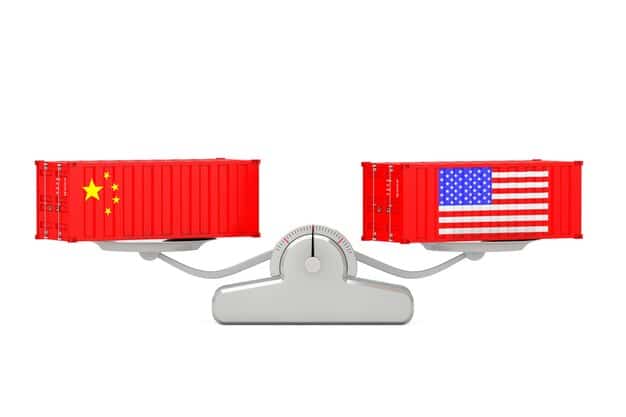US-China Trade Agreement: Key Provisions & Business Impacts

The updated US-China trade agreement addresses key areas such as intellectual property, agriculture, market access, and currency manipulation, significantly impacting how US businesses operate within and trade with China.
Navigating the complexities of international trade can be daunting, especially when it involves major players like the United States and China. Understanding what are the key provisions of the updated US-China trade agreement and how will they affect businesses is essential for strategic decision-making.
Understanding the Foundations of the US-China Trade Relationship
The trade relationship between the United States and China is one of the most significant in the world, impacting global economics, politics, and business strategies. This relationship has evolved significantly over the decades, marked by periods of cooperation, competition, and tension.
Understanding its foundations is crucial for grasping the nuances of any updated trade agreements.
Historical Context of US-China Trade
Initially, trade relations were limited but gradually increased after China’s opening-up policy. Key milestones include China’s entry into the World Trade Organization (WTO) in 2001, which significantly boosted trade volumes.
- The US benefited from lower-cost imports, while China gained access to advanced technologies and markets.
- However, the relationship has also faced challenges, including trade imbalances and disputes over intellectual property rights.
- Political factors and differing economic systems have frequently added complexity.
Recent trade tensions, marked notably by tariff wars, underscore the necessity of understanding the context behind current and future trade agreements. Examining the past policies enables businesses to predict more accurately the implications of upcoming changes for their operations.

Key Provisions of the Updated Trade Agreement
The updated US-China trade agreement addresses several critical areas that impact businesses. These provisions aim to resolve previous trade imbalances, protect intellectual property, and enhance market access.
A closer look at these key provisions uncovers the specific commitments between the US and China.
Intellectual Property Protections
One major aspect of the agreement is the increased protection of intellectual property (IP). This addresses long-standing concerns about theft and counterfeiting.
- Enhanced enforcement mechanisms have been put in place to tackle IP infringement.
- Greater legal recourse is available for US companies facing IP theft in China.
- This includes stricter penalties for those involved in counterfeiting and piracy.
Stronger protections aim to foster a more level playing field for US companies operating in China, encouraging greater innovation and investment.
Agriculture and Market Access
A significant part of the agreement involves commitments from China to purchase a certain amount of US agricultural products. Expanded market access for US agricultural goods is a central tenet of the agreement.
- Specific quotas have been set for various agricultural commodities, such as soybeans, corn, and wheat.
- This addresses US concerns about agricultural trade imbalances.
- It also provides new opportunities for US farmers and agricultural businesses.
Increased market access is anticipated to boost US agricultural exports, supporting the agricultural sector and helping to reduce the trade deficit.
Currency Manipulation Clause
The trade agreement includes a clause addressing currency manipulation. This aims to prevent either country from devaluing its currency to gain a trade advantage.
The agreement enforces high standards of transparency concerning exchange rate policies. Through deterring unfair currency practices, it aims to ensure fair trade practices between both countries.
These measures serve to stabilize the economic relationship, creating a more predictable environment for businesses that engage in international trade between the US and China.

Impact on US Businesses
The updated US-China trade agreement has wide-ranging implications for US businesses, both large and small. These can affect companies operations, import/export strategies, and competitiveness.
It behooves businesses to comprehend these repercussions and adjust their approaches accordingly.
Positive Effects of the Agreement
Many US businesses stand to benefit from the new trade agreement. Sectors like agriculture, technology, and manufacturing could see significant improvements.
- Improved market access creates new revenue streams for agricultural companies.
- Stronger IP protections foster innovation and attract foreign investment.
- Reduced trade barriers can lower costs and increase competitiveness.
These advantages create opportunities for firms to expand, innovate, and develop, supporting long-term financial growth.
Challenges and Considerations
Despite its potential benefits, the agreement also presents challenges. Companies need to navigate new regulations, manage costs, and adapt to changing market dynamics.
Changes to custom duties and export needs may place stress on smaller businesses, particularly those not having dedicated resources or compliance teams. Therefore, businesses should conduct thorough and continuous analyses of what implications the updated agreement brings.
Careful strategizing and adaptability are essential to effectively manage any challenges that may arise as the agreement evolves.
Strategic Implications for Global Trade
The US-China trade relationship has broad implications for the global trade landscape. Any agreement between these juggernauts can influence trade flows, supply chains, and international relations worldwide.
Thus, it’s imperative to understand how these changes can set off ripple effects across the global marketplace.
Influence on Global Supply Chains
The agreement affects global supply chains by altering trade routes and sourcing decisions. Businesses may need to reevaluate their supply chain strategies.
- Companies may diversify sourcing to reduce dependence on a single country.
- Some could relocate operations to take advantage of more favorable trade terms.
- These shifts can have significant impacts on employment and investment patterns globally.
Managing these changes requires a broad and flexible approach, emphasizing resilience and adaptability in dynamic environments.
Geopolitical Repercussions
The US-China trade agreement has geopolitical implications, affecting relationships with other countries. Alliances and negotiations may shift as countries recalibrate their trade strategies.
These political considerations shape trade policies and international alliances. Countries need to consider these complex dynamics to be able to implement reliable and successful trade approaches.
Continuous evaluation of both the economic and political environment can help companies to take prudent action in an era of continued uncertainty.
Preparing for the Future of US-China Trade
Looking ahead, the future of US-China trade remains uncertain yet filled with opportunity. Companies that proactively anticipate and prepare for upcoming changes are most likely to succeed.
Companies may benefit by taking a long-term perspective and building expertise in international trade practices.
Risk Management is Key
Effective risk management is essential in navigating the complexities of international trade. Companies should diversify risk mitigation strategies.
Careful analysis and compliance can aid companies greatly in managing those kinds of challenges. By establishing solid risk management foundations, enterprises can improve their durability and competitive advantages.
Risk assessment that is both proactive and well-informed facilitates companies to anticipate challenges and respond in a nimble manner.
Staying Informed and Adaptive
Keeping up with the trends is the most valuable thing businesses can do to plan for the future. Adaptability and a broad awareness will support success and reduce the impact of any negative forces.
Sustained learning through trade periodicals and groups can sharpen companies’ capabilities in worldwide operations. Remaining tuned into progress improves the resilience and flexibility of enterprises.
Preparing for future trade agreements requires vigilance, responsiveness, and a commitment to sustainable practices.
| Key Aspect | Brief Description |
|---|---|
| 🛡️ IP Protection | Stronger enforcement against theft and counterfeiting. |
| 🚜 Agriculture | China commits to purchasing specific amounts of US agricultural goods. |
| 💰 Currency | Agreement includes measures to prevent currency manipulation. |
| 📈 Market Access | Enhanced opportunities for US companies in the Chinese market. |
Frequently Asked Questions
▼
The primary goal is to address trade imbalances and enhance protections for intellectual property, while also promoting fair competition. It aims to create a more balanced and predictable trade environment.
▼
The agreement includes stronger enforcement mechanisms to prevent IP theft and counterfeiting. It provides US companies with greater legal recourse against IP violations in China, ensuring better protection.
▼
The agreement focuses on increasing purchases of US agricultural goods, including soybeans, corn, wheat, and other commodities. Specific quotas have been set to boost agricultural exports from the US to China.
▼
The agreement includes a clause that enforces transparency in exchange rate policies. It aims to deter either country from devaluing its currency for trade advantages, fostering a stable economic environment.
▼
Businesses should stay informed about trade developments, diversify their supply chains, and adopt proactive risk management strategies. Adapting to evolving market dynamics and building resilience are essential for success.
Conclusion
In conclusion, the updated US-China trade agreement represents a significant step towards resolving trade imbalances and establishing a more balanced economic relationship. While it offers potential benefits for many US businesses, particularly in the agricultural and technology sectors, it also presents challenges that require careful navigation. By staying informed, adapting to changing market dynamics, and proactively managing risks, businesses can effectively navigate the complexities of the US-China trade landscape and position themselves for long-term success.





